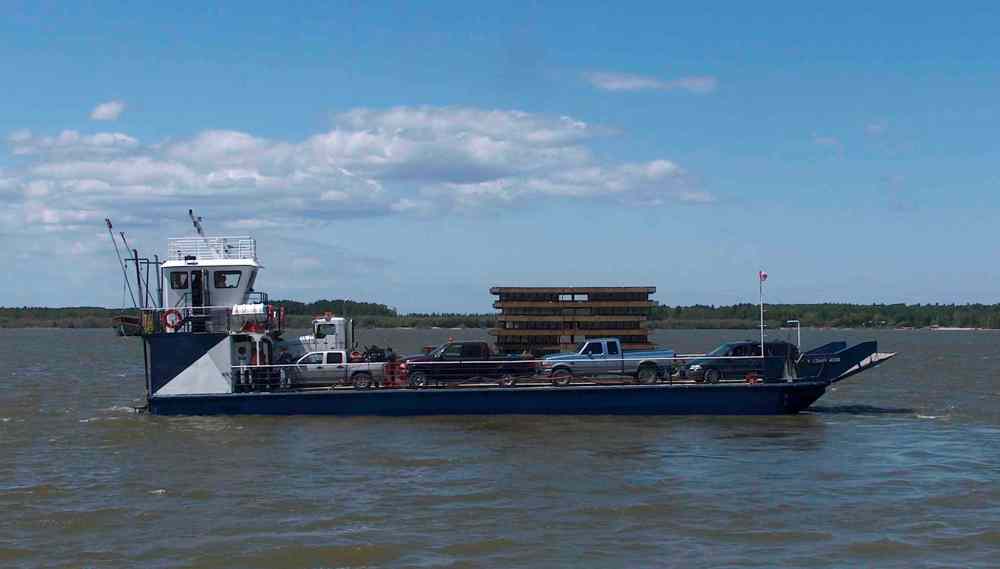End of a ferry tale: Edgar Wood falls prey to roads, light aircraft after 35-year run
Advertisement
Read this article for free:
or
Already have an account? Log in here »
To continue reading, please subscribe:
Monthly Digital Subscription
$0 for the first 4 weeks*
- Enjoy unlimited reading on winnipegfreepress.com
- Read the E-Edition, our digital replica newspaper
- Access News Break, our award-winning app
- Play interactive puzzles
*No charge for 4 weeks then price increases to the regular rate of $19.00 plus GST every four weeks. Offer available to new and qualified returning subscribers only. Cancel any time.
Monthly Digital Subscription
$4.75/week*
- Enjoy unlimited reading on winnipegfreepress.com
- Read the E-Edition, our digital replica newspaper
- Access News Break, our award-winning app
- Play interactive puzzles
*Billed as $19 plus GST every four weeks. Cancel any time.
To continue reading, please subscribe:
Add Free Press access to your Brandon Sun subscription for only an additional
$1 for the first 4 weeks*
*Your next subscription payment will increase by $1.00 and you will be charged $16.99 plus GST for four weeks. After four weeks, your payment will increase to $23.99 plus GST every four weeks.
Read unlimited articles for free today:
or
Already have an account? Log in here »
Hey there, time traveller!
This article was published 21/10/2015 (3694 days ago), so information in it may no longer be current.
The first link in the east-side road turned out to be the final nail in the coffin for Lake Winnipeg Narrows’ ferry service, which has been cancelled after 35 years.
On Oct. 14, the M.V. Edgar Wood made its final 14-kilometre trip between Bloodvein First Nation on the east side of Lake Winnipeg to Islandview on the west side, at the end of PR 234.
The 27-metre self-propelled ferry boat, built in 1959, has been carrying cars, trucks and pedestrians across the narrows since 1980. It served as the only warm-weather link between Bloodvein and the rest of Manitoba until 2014, when a 156-kilometre road connecting PR 304 to the First Nation was completed.
Manitoba Infrastructure and Transportation operated the ship one more season along its regular route, which also served the small east-side outpost of Princess Harbour.
A drastic decline in traffic this year led the province to mothball its oldest ferry, which sailed Oct. 15 to Selkirk, where it awaits decommissioning.
“Right now, we have no future plans for this boat,” said Mike Knight, director of northern airports and marine operations for Manitoba Infrastructure and Transportation.
“We have to figure out if there’s any other place it’s needed. But it would have to be cut into pieces, moved off Lake Winnipeg and put back together. Those are significant costs, and it’s a very old boat.”
The Edgar Wood was one of five ferries that served as links in Manitoba’s highway system.
A second self-propelled ferry makes the 21-kilometre trip between Tataskweyak Cree Nation and York Landing on Split Lake. Cable ferries operate on South Indian Lake, on the Nelson River at Sea Falls and on a channel of Lake Winnipeg at Matheson Island.
The Lake Winnipeg Narrows ferry, however, was arguably Manitoba’s best known, as it was used by Bloodvein residents as well as by paddlers who completed whitewater trips on the Bloodvein River.
“I’ve seen canoeists on that ferry from virtually every corner of the globe. It’s amazing how many people have paddled down that river,” said Barry Blair, Manitoba Infrastructure’s marine projects manager.
The end of the ferry service is even more significant for longtime residents of Lake Winnipeg’s northern basin, where marine traffic has dwindled precipitously since the middle of the 20th century.
The extension of roads, flights by small aircraft and small privately owned boats have all supplanted larger ships, said David Stephanson, who served as the Edgar Wood’s captain from 1982 until last week.

“You’d see a ship going by every day in the ’60s and ’70s. There used to be 25 or 30 on the lake. A lot of them are sunk now, and some are in the (Marine) Museum,” said Stephanson, who served with the Coast Guard before becoming a ferry captain.
While the Lake Winnipeg crossing was not as long as the M.V. Joe Keeper’s route on Split Lake, the Edgar Wood faced far more treacherous waters. The Lake Winnipeg Narrows are famously turbulent, especially when a strong northwestern wind spawns large waves and creates unpredictable currents.
“It’s the roughest water anywhere on Lake Winnipeg,” Stephanson said.
While Transport Canada placed strict operating conditions on the ferry, its captain still found himself steering a big, flat boat through waves as high as three metres.
“It gets pretty dicey at times, when you get waves coming from different directions and you have to fight the sea,” Stephanson said. “The weather has really changed, especially in the summer. Now, you get caught in these waterspouts. You just aim your ferry into them.”
Rough water is no longer Stephanson’s concern. The construction of the road to Bloodvein has forced him into retirement on Matheson Island.
“I didn’t think it would happen in my lifetime. Now that it has, I’m glad for the people there, for them to get access to the south. I hope they build (the road) all the way to where they’re supposed to build it before I push up daisies,” Stephanson said.
“It’s kind of sad. But I’ve done my stint. It’s time for me to put my feet up and take it easy.”
History
Updated on Wednesday, October 21, 2015 10:19 PM CDT: Adds copy.
Updated on Wednesday, October 21, 2015 10:28 PM CDT: Adds copy.


